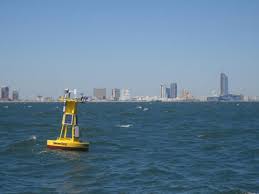With momentum slowly building toward bigger wind energy plans for the Atlantic continental shelf, proponents of floating turbines have their first proposals in for tackling wind-rich areas in Pacific deep water.
The latest is Trident Winds’ Morro Bay project, a nearly 68,000-acre area 20 to 30 miles off the California coast that would generate up to 800 megawatts from 100 turbines on floating foundations, linked by cables suspended far above the 2,600’ to 3,300’ depths.
Trident’s approach to the federal Bureau of Ocean Energy Management was preceded by the company reaching out on its own to California state and local officials, environmental and fishing industry groups, all players in the politics of California’s heavily regulated coastal zone.
Three plans for Hawaii – from Progression Hawaii Offshore Wind LLC, Honolulu, a subsidiary of Progression Energy based in Portland, Ore., and AW Hawaii Offshore Wind Inc., a Honolulu subsidiary of the Alpha Wind Energy partnership headquartered in Denmark – would float turbines in waters as deep as 2,700’. They would be relatively modest projects compared to Morro Bay, at around 400 megawatts each, but still enough to power 25% of Oahu’s needs.
A Fishermen's Energy environmental monitoring buoy off New Jersey. Fishermen's Energy photo.Those moves in the Pacific come amid quickening interest in Atlantic wind projects. Fishermen’s Energy says its revised New Jersey plan using Siemens machines for a 24-megawatt demonstration project just off Atlantic City’s beaches means power from the project will now come in cheaper than its original plan that was rejected by state utility regulators.
“The proposed Atlantic City offshore wind demonstration project can now sell its power for 30% less than contemplated two years ago, thanks to substantial federal funding and incorporation of the best of European and American know-how,” company CEO Chris Wissemann wrote in a March 23 letter urging Gov. Chris Christie to allow a new plan submission.
With or without Christie’s approval, bigger plans are afoot outside state waters. In February, Dong Energy A/S of Denmark, a major player in the European offshore wind industry, announced it would take on development rights for a 1,000-megawatt project off New Jersey, on a 160,480-acre lease obtained from BOEM in a November auction by Res Americas Development Inc.
Dong already has a lease for a similar size project in waters south of Martha’s Vineyard, Mass., far enough offshore to avoid the visual impacts that marshalled so much local opposition to Cape Wind’s ill-fated wind energy plans for Nantucket Sound. Samuel Leopold, executive vice president of wind power for Dong, called the U.S. Atlantic waters “an interesting market for offshore wind…The site conditions are quite similar to those we currently work with in North-Western Europe, which means that the project could be developed using well-known technology."
That could bring new economies of scale and industry experience, after years of false starts, and for some proposals, sketchy equipment and financing. Offshore companies like Dong and turbine manufacturers like Siemens are moving to bigger-is-better efficiencies, and with BOEM’s opening of offshore federal waters that could be the game changer.
If the first floating turbines plans gain traction, that could bring a similar convergence to bear on American deepwater areas. Trident founder Alla Weinstein is former CEO of Principle Power Inc., which developed the WindFloat foundation tested off Portugal and could be the support for the California and Hawaii arrays.
Norway-based Statoil is in the floating turbine game too, with its 30-megawatt Hywind project to be deployed off Scotland. Beyond their use in deepwater sites, floating foundations could bring down the cost associated with seafloor foundations. That’s another way a trans-Atlantic, and ultimately globalized offshore wind energy industry might drive down costs, just as American companies showed the way in oil.




